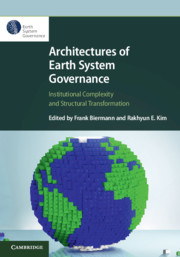Book contents
- Architectures of Earth System Governance
- Series page
- Architectures of Earth System Governance
- Copyright page
- Contents
- Contributors
- Acknowledgements
- 1 Architectures of Earth System Governance
- Part I The Building Blocks
- Part II Core Structural Features
- Part III Policy Responses
- 9 Policy Integration
- 10 Interplay Management
- 11 Orchestration
- 12 Governance through Global Goals
- 13 Hierarchization
- Part IV Future Directions
- Glossary
- Index
- References
9 - Policy Integration
from Part III - Policy Responses
Published online by Cambridge University Press: 17 April 2020
- Architectures of Earth System Governance
- Series page
- Architectures of Earth System Governance
- Copyright page
- Contents
- Contributors
- Acknowledgements
- 1 Architectures of Earth System Governance
- Part I The Building Blocks
- Part II Core Structural Features
- Part III Policy Responses
- 9 Policy Integration
- 10 Interplay Management
- 11 Orchestration
- 12 Governance through Global Goals
- 13 Hierarchization
- Part IV Future Directions
- Glossary
- Index
- References
Summary
Environmental policy integration (EPI) is the incorporation of environmental concerns and objectives into non-environmental policy areas, such as energy, transport and agriculture, as opposed to pursuing such objectives through purely environmental policy practices. EPI is promoted to overcome policy incoherence and institutional fragmentation, to address the driving forces of environmental degradation and to promote innovation and synergy. But how effective are EPI strategies employed in practice? In this chapter we provide a meta-analysis of scientific, empirical research on EPI to address this question. An important finding is the discrepancy between the adoption of EPI in terms of objectives and commitments and its actual implementation, that is, translation into concrete measures. Overall, we found relatively few cases where environmental objectives were given a substantial status in non-environmental policies. The barriers we identified suggest that the actual detailed design or architecture of the strategies that are employed to promote EPI really matters.
- Type
- Chapter
- Information
- Architectures of Earth System GovernanceInstitutional Complexity and Structural Transformation, pp. 183 - 206Publisher: Cambridge University PressPrint publication year: 2020
References
- 13
- Cited by

